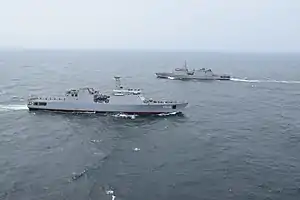INS Sumedha
INS Sumedha (P58) is the third Saryu-class patrol vessel of the Indian Navy, designed and constructed indigenously by the Goa Shipyard Limited.[2][3] It is designed to undertake fleet support operations, coastal and offshore patrolling, ocean surveillance and monitoring of sea lines of communications and offshore assets and escort duties.[4][5]
_en-route_to_Bangladesh_(cropped).jpg.webp) INS Sumedha (P58) en-route to Mongla, Bangladesh | |
| History | |
|---|---|
| Name | INS Sumedha |
| Namesake | Sumedha |
| Operator | |
| Builder | Goa Shipyard Limited |
| Launched | 21 May 2011 |
| Completed | 15 January 2014 |
| Status | in active service |
| General characteristics | |
| Class and type | Saryu-class patrol vessel |
| Tonnage | 2,200 tonnes (2,200 long tons; 2,400 short tons) |
| Length | 105 m (344 ft) |
| Propulsion | Two KOEL/Pielstick Diesel engines |
| Speed | 25 knots (46 km/h; 29 mph) |
| Range | 6,000 nautical miles (11,000 km; 6,900 mi) at 16 knots (30 km/h; 18 mph) |
| Complement | Eight officers and 108 sailors |
| Armament |
|
Construction
The Naval Offshore Patrol Vessel INS Sumedha was launched at Goa Shipyard on 21 May 2011,[6] and was handed over to the Indian Navy on 11 March 2014.[7]
Gallery
_and_INS_Kulish_(P63)_enroute_to_Bangladesh.jpg.webp) INS Sumedha (P58) and INS Kulish (P63) enroute to Bangladesh.
INS Sumedha (P58) and INS Kulish (P63) enroute to Bangladesh. SLNS Sindurala (P624) and INS Sumedha during SLINEX 2019.
SLNS Sindurala (P624) and INS Sumedha during SLINEX 2019. INS Sumedha during exclusive economic zone surveillance of Maldives, 2018
INS Sumedha during exclusive economic zone surveillance of Maldives, 2018_and_INS_Sumedha_(P59)_enroute_to_Bangladesh.jpg.webp) INS Kulish and INS Sumedha enroute to Bangladesh
INS Kulish and INS Sumedha enroute to Bangladesh
See also
References
- "INS Sunayna to Extend SNC's Reach". Press Information Bureau. 15 October 2013. Retrieved 16 October 2013.
- "Goa Shipyard Limited touches 200 mark, largest NOPV handed over to Navy". The Times of India. 16 January 2014. Archived from the original on 16 January 2014. Retrieved 16 January 2014.
- "Third OPV Joins Indian Navy". Naval Today. 16 January 2014. Retrieved 16 January 2014.
- "INS Sunayna commissioned to enhance Indian navy's prowess". The Indian Express. 16 October 2013. Retrieved 16 October 2013.
- "Goa Shipyard Ltd delivers offshore patrol vessel to Navy". Business Standard. 16 January 2014. Retrieved 16 January 2014.
- "Hon'ble Raksha Mantri to Commission GSL Modernisation Project". Goashipyard.co.in. Retrieved 12 January 2013.
- "Indian Navy Commissions third Saryu class Offshore Patrol Vessel INS "SUMEDHA"". 11 March 2014.
External links
Wikimedia Commons has media related to INS Sumedha (P58).
This article is issued from Wikipedia. The text is licensed under Creative Commons - Attribution - Sharealike. Additional terms may apply for the media files.